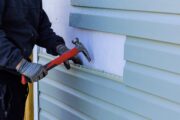(BPT) – Whether it’s regular outdoor entertaining, kids playing soccer or dogs chasing tennis balls, fun on the lawn — combined with hot, dry conditions — can mean your grass gets a major workout during the summer and early fall. But that doesn’t mean you have to.
To keep your lawn looking sharp without breaking your back, follow these five simple tips.
1. Mow high. Crew cuts are out. Don’t fall for the myth that the shorter you cut your grass, the less often you’ll have to mow. Leaving the grass blades a bit longer allows them to shade the roots and provides more leaf surface for making food, so you can water, feed and mow less often. The type of grass in your lawn will determine the height you should set your mower, but most turfgrasses can be allowed to grow 3 inches tall in the summer before the top one-third of the blades is removed by mowing.
2. Find the most efficient mowing pattern. Most people mow their lawns in rows, and that’s usually the fastest way to do it. If you have a more-or-less rectangular lawn, mowing in lengthwise rows (along the longest side of the lawn) will reduce the number of turns you need to make and thus speed up the job. Another option is to work in concentric circles — this can be more efficient because the turns are all in the same direction and, except at the very center, they’re not as sharp, so you can maneuver the mower better. Whatever pattern you choose, be sure to overlap the rows a bit so you don’t have to go back later and clean up areas you missed.
3. Leave the clippings. If you aren’t cutting off more than one-third of the height of the grass blades (which you shouldn’t be anyway, as this stresses the plants), you don’t need to bag the clippings. Just leave them on the lawn and they’ll break down easily, providing the soil with nitrogen, phosphorus and potassium — the same nutrients found in commercial fertilizer. Clippings don’t cause thatch, and leaving them on the grass is a zero-cost, zero-effort way to feed your lawn. If you have a mulching mower, you can also mulch in fallen leaves in the fall to add extra nutrients and save time raking.
4. Water thoroughly but less frequently. Many homeowners think they need to water their lawns daily, but turfgrass actually prefers a thorough watering once or twice a week rather than a light misting every day. Allowing the soil to dry between waterings encourages the grass to grow deeper roots and can improve the lawn’s drought tolerance. So take watering off your daily to-do list and irrigate only when needed. A quick way to determine whether your lawn needs to be watered is to push a screwdriver into the soil. If it goes in without difficulty, the grass has enough water already. If the ground is so hard that the screwdriver doesn’t penetrate easily, it’s time to start up the sprinklers.
5. Overseed now to save time later. Overseeding in the fall, before cold temperatures hit, can save you significant time next spring and summer. Fall overseeding with a cool-season seed blend can help your lawn emerge from the winter thicker and healthier, improving the grass’s ability to fight insects, diseases and weeds in the spring — meaning less weed pulling, spot seeding and early-season lawn revitalization. Cool-season grasses should usually be planted by mid-September, and warm-season grasses by mid-October. You’ll want to avoid drastic temperature changes and water regularly yet moderately so the seed has time to absorb moisture and build strong roots. A bit of extra effort now will pay off in the spring with a lush, low-maintenance lawn.
“A lawn is a great asset that provides the perfect environment for a wide variety of outdoor activities,” said Bryan Ostlund, executive director of Grass Seed USA, a coalition of American grass seed farmers and turf specialists. “If you’re lucky enough to have space for grass, don’t let the maintenance become a burden. Simplifying your lawn care practices and working more efficiently can help you enjoy a healthy lawn all season long without hours and hours of labor.”


